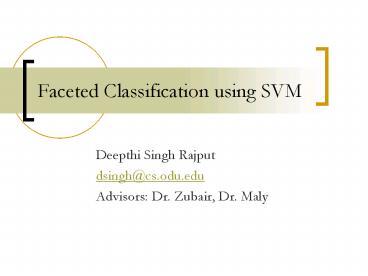Faceted Classification using SVM - PowerPoint PPT Presentation
1 / 30
Title:
Faceted Classification using SVM
Description:
News Articles. Image Collection. American Political History. State Department Collection ... News Articles: 500 documents. 8 categories. Large feature set. ... – PowerPoint PPT presentation
Number of Views:36
Avg rating:3.0/5.0
Title: Faceted Classification using SVM
1
Faceted Classification using SVM
- Deepthi Singh Rajput
- dsingh_at_cs.odu.edu
- Advisors Dr. Zubair, Dr. Maly
2
Overview
- Proposal
- Approach
- SVM overview
- Implementation
- Integration
- Conclusion
3
Collaborative Faceted Classification
- Faceted classification
- Multiple perspectives.
- Mutually exclusive facets
- Each facet is a hierarchy
- Simple and easy to explore
- EX
- C//subfolder/test.txt
- Type, size, date of mod
4
Collaborative Faceted Classification
- Collaborative Classification
- Collaboratively build faceted classification
- Add, modify facets
- Categorize, reclassify documents
- Automated Classification (Supervised Learning
Problem) - Collaboration dynamically changes the facet
schema - Calls for automatic reclassifying of existing
documents - Manual classification / reclassification of huge
collections is time consuming.
5
Objective
- Use of Support Vector Machine (SVM) to implement
a system which - Automates Document classification into predefined
facets - Suggests classifications for new documents.
- Reclassifies documents with changing faceted
schema.
6
Approach
- Boot Strapping
- Non classified collection of documents.
- A facet for this collection is defined manually
- Manually, a subset of the collection is
classified into positive and negative sets (w.r.t
to the facet). - The system is trained to identify the documents
of each set as positive or negative using
automated learning.
7
Approach
- Soft classification The rest of the collection
is tentatively classified by the system using the
training set. - Soft classifications are made available to users
for exploration. - Soft Classifications can be hardened or
rejected by the users.
8
Approach
- Real Time Classification
- Users may contribute new documents to the
collection. - The system tentatively classifies the document.
- Users can
- approve of the suggested classification
- classify as they wish, into the existing facet
schema. - Change the schema by creating a new category or
facet for the document. - With change in the facet schema the system
reclassifies the documents.
9
Example Collection Schema
- News Articles
- Image Collection
- American Political History
- State Department Collection
- African American Activists
10
Technologies Used
- jdk1.5.0_05
- IDE Eclipse
- Maven 2.0.4
- LibSVM
11
SVM Overview
- Statistical Learning Theory
- Widely used in pattern recognition
- Important and active field of all Machine
Learning research. - An instance of Kernel Machines, a large class of
learning algorithms.
12
Good Decision Boundary
- Consider a two-class, linearly separable
classification problem - Many decision boundaries!
- The Perceptron algorithm can be used to find such
a boundary - Are all decision boundaries equally good?
Class 1
Class 2
13
Large-margin Decision Boundary
- The decision boundary should be as far away from
the data of both classes as possible - We should maximize the margin, m
14
Kernel Mapping Computing feature space
15
SVM Implementation
- Transform data to the format of an SVM software
- Conduct simple scaling/normalization on the data
- Consider the RBF kernel
- Find the best parameter C and Gamma
- Use the best parameter C and Gamma to train the
training set - Test
16
Transformation
- The collection has to be transformed to a format
of the SVM library (LibSVM) - Every training collection contains a number of
different documents (Document Frequency) - Documents contain different terms and term
frequencies. - Term Frequency (TF) and Document Frequency are
used to compute the features.
17
LibSVM format
- Each document represents a line in the SVM model
- Each line starts with a class label (0,1)
followed by feature (Id, value) pairs - label featureIdfeatureValue
featureIdfeatureValue - Training and Testing files have the same format.
18
Scaling and Kernel
- Scaling
- avoid attributes in greater numeric ranges
dominate those in smaller numeric ranges. - RBF Kernel
- Number of hyper parameters influences the
complexity of model selection. - Polynomial kernel has more hyper parameters than
the RBF kernel.
19
Training
- Identify good (C, ?) so that the classifier can
accurately predict unknown data - Train the system with a set of positive and
negative documents. - Calculate the training accuracy.
- Iterate with different sample set sizes.
- Pick the best one avoid over fitting and under
fitting.
20
Testing
- Test with a set of positive and negative samples
- Determine the accuracy of prediction
- P of positive documents
- N of Negative documents
- RP Positive documents rightly classified
- RN Negative documents rightly classified
- Accuracy (RP RN) / (PN)
21
Integration
- Integration with the Collaborative Faceted
Classification to achieve - Boot Strapping
- Real Time Classification
22
Experiments and Results
- Image Collection
- 518 documents
- 18 categories
- Sparse feature set
- News Articles
- 500 documents
- 8 categories
- Large feature set.
- Training set 40, 80, 100
- Testing 30, 40
23
News Articles 40-40
24
Over fitting 100 40
25
Image Collection 40- 30 (under fitting)
26
Image 80 - 30
27
Impact of sample size
28
Conclusions
- Unstable on small sized training sets
- Over Fitting
- Large training sets with far less feature
dimensions (Image Collections) - Small training sets with a small set of feature
dimensions. - Under Fitting
- Large features dimensions than training sets.
- Need to choose a subset of them before giving the
data to SVM.
29
Future Work
- Re-classification
- Approval of the schema
- Point of Reclassification
- Training set
30
References
- http//128.82.7.230/categorization/developers/svmh
mm.ppt - http//www.csie.ntu.edu.tw/cjlin/papers/guide/gui
de.pdf - http//www.csie.ntu.edu.tw/cjlin/libsvm
- http//128.82.7.230/categorization/joachims.pdf
- http//www.csie.ntu.edu.tw/cjlin/libsvm/faq.html































